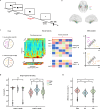Enhanced role of the entorhinal cortex in adapting to increased working memory load
- PMID: 40593531
- PMCID: PMC12217308
- DOI: 10.1038/s41467-025-60681-w
Enhanced role of the entorhinal cortex in adapting to increased working memory load
Abstract
In daily life, we frequently encounter varying demands on working memory (WM), yet how the brain adapts to high WM load remains unclear. To address this question, we recorded intracranial EEG from hippocampus, entorhinal cortex (EC), and lateral temporal cortex (LTC) in humans performing a task with varying WM loads (load 4, 6, and 8). Using multivariate machine learning analysis, we decoded WM load using the power from each region as neural features. The results showed that the EC exhibited both higher decoding accuracy on medium-to-high load and superior cross-regional generalization. Further analysis revealed that removing EC-related information significantly reduced residual decoding accuracy in the hippocampus and LTC. Additionally, we found that WM maintenance was associated with enhanced phase synchronization between the EC and other regions. This inter-regional communication increased as WM load rose. These results suggest that under higher WM load, the brain relies more on the EC, a key connector that links and shares information with the hippocampus and LTC.
© 2025. The Author(s).
Conflict of interest statement
Competing interests: The authors declare no competing interests.
Figures





Similar articles
-
Distinct neural patterns for various information in working memory: A brain connectivity study.PLoS One. 2025 Jul 3;20(7):e0326449. doi: 10.1371/journal.pone.0326449. eCollection 2025. PLoS One. 2025. PMID: 40608816 Free PMC article.
-
The entorhinal-DG/CA3 pathway in the medial temporal lobe retains visual working memory of a simple surface feature.Elife. 2023 Mar 2;12:e83365. doi: 10.7554/eLife.83365. Elife. 2023. PMID: 36861959 Free PMC article.
-
Working memory capacity modulates Serial dependence in facial Identity: Evidence from behavioral and EEG data.Vision Res. 2025 Feb;227:108542. doi: 10.1016/j.visres.2025.108542. Epub 2025 Jan 17. Vision Res. 2025. PMID: 39826471
-
Systemic pharmacological treatments for chronic plaque psoriasis: a network meta-analysis.Cochrane Database Syst Rev. 2021 Apr 19;4(4):CD011535. doi: 10.1002/14651858.CD011535.pub4. Cochrane Database Syst Rev. 2021. Update in: Cochrane Database Syst Rev. 2022 May 23;5:CD011535. doi: 10.1002/14651858.CD011535.pub5. PMID: 33871055 Free PMC article. Updated.
-
Systemic pharmacological treatments for chronic plaque psoriasis: a network meta-analysis.Cochrane Database Syst Rev. 2017 Dec 22;12(12):CD011535. doi: 10.1002/14651858.CD011535.pub2. Cochrane Database Syst Rev. 2017. Update in: Cochrane Database Syst Rev. 2020 Jan 9;1:CD011535. doi: 10.1002/14651858.CD011535.pub3. PMID: 29271481 Free PMC article. Updated.
References
-
- Owen, A. M. Working memory: imaging the magic number four. Curr. Biol.14, R573–R574 (2004). - PubMed
-
- Brockhoff, L., Schindler, S., Bruchmann, M. & Straube, T. Effects of perceptual and working memory load on brain responses to task-irrelevant stimuli: Review and implications for future research. Neurosci. Biobehav. Rev.135, 104580 (2022). - PubMed
-
- Wang, Y. et al. Fronto-parietal activity changes associated with changes in working memory load: Evidence from simultaneous electroencephalography and functional near-infrared spectroscopy analysis. Eur. J. Neurosci.60, 5413–5427 (2024). - PubMed
MeSH terms
Grants and funding
- 32271085/National Natural Science Foundation of China (National Science Foundation of China)
- 32400883/National Natural Science Foundation of China (National Science Foundation of China)
- 5244049/Natural Science Foundation of Beijing Municipality (Beijing Natural Science Foundation)
- 204651/WT_/Wellcome Trust/United Kingdom
LinkOut - more resources
Full Text Sources

